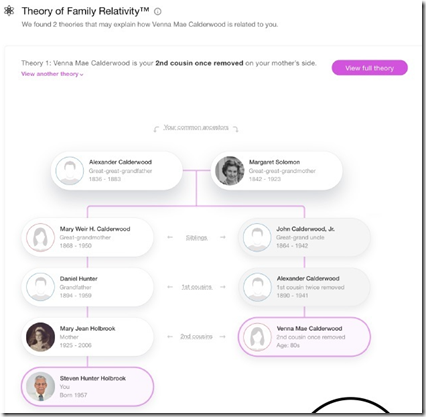Today’s the first day of #RootsTech. This is the day that many of the genealogy companies announce new features on their site.
So it is not ironic at all that today, both AncestryDNA and MyHeritage DNA announced a new feature that matches up your tree with the trees of your DNA matches and shows you the results.
DNA matching is a tool to assist your genealogy research. But up to now, you’ve had to do most of the tree inspection on your own. Finally, we’ve got not one, but two new automated system to save lots of time.
Ancestry DNA
Ancestry’s official announcement may come tomorrow (Feb 28) at RootsTech in Crista Cowan’s talk at 1:30 MST titled. “What You Don’t Know about Ancestry”. This will be live streamed tomorrow, so if you read this post in time, you can listen to Crista live.
To get the new feature, you currently have to go to into your Ancestry account and from the menu, select “Extras” and under that “Ancestry Lab”. Then on the Ancestry Lab page, you should enable their Beta features.
After you opt in, you then can go to your DNA Matches page, and in the “Filtered by” drop down, you’ll see “Common ancestors”. Select that, and hopefully you’ll get a few matches. I got the 4 you see below.
If you click on one of the people’s names, you get the comparison page. There is now a Common Ancestors box. For people who are not in the above list, you’ll get this box:
But for people who are in this list, the box will contain something quite exciting:
The people shown are the common ancestors of myself and my match. Even more exciting is if you now click on the “View relationship” link for either ancestor, you get:
And if you expand those dropdowns that are hiding two generations, it gives:
This match, as well as my other three, are all correct matches. I previously knew my connection to two of these people. The other two were people correctly placed into my tree that I did not know had tested.
This is really great! Finally, the companies are doing something intelligent to match you with your DNA match via your combined trees. Bravo!
I posted a survey on the Facebook group: Genetic Genealogy Tips, to find out how many matches people were getting. Although I only got 4 matches, almost half the people reported between 100 and 999 matches! That’s a lot of connections many people will now be able to make that previously required laborious manual tree inspection.
MyHeritage DNA
MyHeritage at almost exactly the same time implemented almost exactly the same feature. They have already announced their matching system which they call: The Theory of Family Relativity.
To access your matches, go to your MyHeritage DNA Matches page, select “Filters” and then select: “Has Theory of Family Relativity”.
Unfortunately for me, what I get is no results, so I won’t be able to give you a personal illustration of what it looks like.
But I would expect there would likely be a match tree similar to what AncestryDNA gives. This is the illustration from their announcement:
I posted the same survey on Genetic Genealogy Tips asking how many MyHeritage DNA matches everyone had. People generally had fewer matches than at Ancestry DNA, but about 65% did have matches and 10% marked that they had between 20 and 99 with a few having more than 100.
Update: Mar 2, 2019: It seems I took a shortcut to get to the Ancestry Connected Trees. The “Common Ancestors” feature apparently existed before. But I didn’t have any so I didn’t know about it.
The new Ancestry feature is actually called ThruLines and you can get to it from Your DNA Results Summary page:
Clicking through on the “Explore ThruLines” button takes you to a page showing all your direct ancestors:
Any ancestors through which the ThruLines algorithm finds a potential DNA relative will be marked with a “Potential Ancestor” indicator. Three of my ancestors have this:
Clicking on their tiles will then take you to the same 4 connections that I found in my clicking on “Common Ancestors” as I first described in the post. Herz Tzvi and Dwora both take me to the same two DNA relatives (since they were husband/wife) and Manascu takes me to the other two DNA relatives. It it titled “ThruLines” rather than Common Ancestors and can show the connection to more than one DNA relative at a time. But essentially it is the same information, just accessed by ancestor rather than by DNA match.













